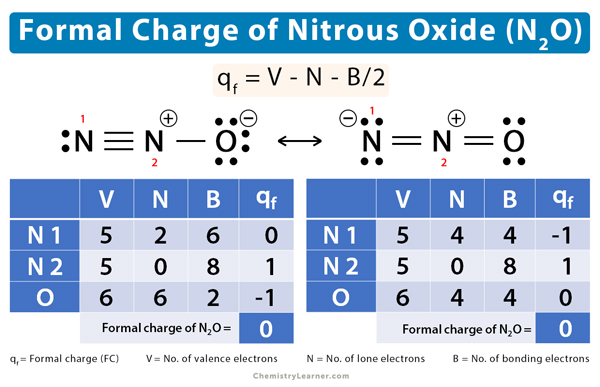Nitrous Oxide (N2O) Formal Charge
In nitrous oxide (N2O), nitrogen (N) bonds with oxygen (O) and with another nitrogen to form two resonance structures, as shown below.
N ≡ N+–O– ↔ N–=N+=O
To understand which one is more stable, let us calculate the formal charge of each structure.
i. N ≡ N+–O–
Here, the two N atoms share a triple covalent bond, and one of them shares a single covalent bond with O. Let us calculate the formal charges of each atom and the net formal charge.
Nitrogen 1
V = 5, N = 2, B = 6
Therefore,
qf = 5 – 2 – 6/2 = 0
Nitrogen 2
V = 5, N = 0, B = 8
Therefore,
qf = 5 – 0 – 8/2 = 1
V = 6, N = 6, B = 2
Therefore,
qf = 6 – 6 – 2/2 = -1
The net formal charge is: 0 + 1 – 1 = 0
ii. N–=N+=O
Here, two nitrogen atoms share a double covalent bond, and one shares a double covalent bond with oxygen. Let us calculate the formal charges of each atom and the net formal charge.
Nitrogen 1
V = 5, N = 4, B = 4
Therefore,
qf = 5 – 4 – 4/2 = -1
Nitrogen 2
V = 5, N = 0, B = 8
Therefore,
qf = 5 – 0 – 8/2 = 1
Oxygen
V = 6, N = 4, B = 4
Therefore,
qf = 6 – 4 – 4/2 = 0
The net formal charge is: -1 + 1 + 0 = 0
Therefore, the formal charge of nitrous oxide is zero for both the resonance structure. It means that both these structures are stable.





